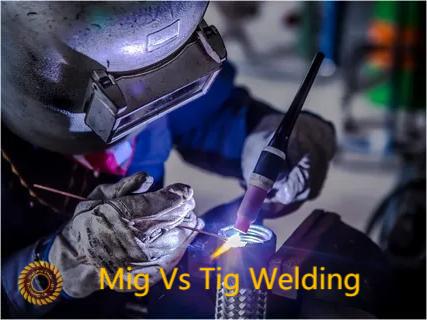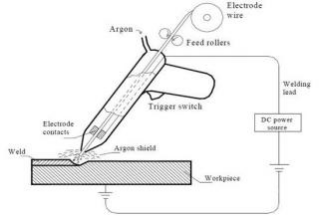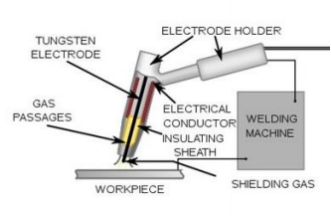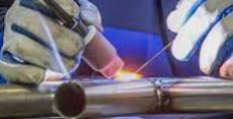Mig Vs Tig Welding: What is the Difference Between?
 Jul 03,2023
Jul 03,2023

Introduction: Stick welding is not the need in all engineering fabrication processes, especially for mass production and miniature parts. Metallurgical design may requires inert atmosphere and shielding gasses during welding. And it needs continuous flow of welding with consumable filler rod melting in pool. Then one has option to find the aspects of Mig vs Tig welding. But to avoid repairs and impurities in it there is need for better understanding of each topic. Thus it is important to study the process parameters and technical study. Otherwise nonconformance will occur due to wrong selection.

Types of Welding
Mainly welding has classes on its physics and process. Origin of heat generation also decide the type of welding. Major classes or types of welding are,
1. Arc Welding.
2. Resistance Welding.
3. Friction Welding.
4. Plasma Welding.
5. Electron Beam Welding.
6. Laser Welding.
What Type of Welding is Mig?
Mig (Metal inert gas) or GMAW (Gas Metal Arc Welding) are equivalent nomenclature. It takes filler metal wire from rotating wheel of equipment and shielding gasses from torch cavity through cylindrical vessel. Heat production occurs at the junction of wire and bevel space. Shielding gasses composition decides mig mag nomenclature. It uses around forty to fifty percent carbon dioxide to counter the hazardous effect of air on molten pool. Famous gas for welding process is Argon and helium. Mag (Metal active gas welding) uses active gas for weld chemistry and filler material. This welding process uses equipment of welding wire spool rotation and shielding gasses control mechanism.
Mig Welding Diagram
This welding process consists of Electric source, Consumable feed wire roll, Argon or carbon dioxide shielding gasses to prevent molten pool. Electric supply creates voltage difference between workpiece and metallic part to produce arc between them. In the parallel shielding gas and electrode wire comes to workpiece. Figure..No. 1 shows MIG welding diagram.

Figure.No.1. MIG Welding Diagram.
What Type of Welding is TIG?
Tig or Tungsten Inert Gas Welding are equivalent nomenclature. It produces heat between non consumable rod and bevel space to fuse the material. While on consumable rod will not melt in the process. Because tungsten melting point is 3400 centigrade and weld pool temperature is 1600 centigrade. Filler rod comes at an angle with respect to tungsten electrode. This non consumable tungsten electrode does not vanish to become part of bevel liquid pool. Thus it provides better control and precision of weld bead during layer deposition. Aesthetics of weld bead is also good looking.
Tig Welding Diagram
Tig welding equipment is equivalent conventional welding equipments but it contain non consumable conductor in center of torch. In the first step shielding produces protective cover on weld pool area. Then electric arc produces enough heat to melt the filler material. And weld bead comes to existence.Figure. No. 2 shows the Tig welding diagram.

Figure.No.2.Tig Welding Diagram.
Difference Between MIG and TIG Welding
Key difference with respect engineering floor level are present in Table.No. 1. Tig Welding Mig Welding -Slow and accurate. -Faster and Cheaper. -Provide inert atmosphere. -Active gasses are also option. -Difficult for beginners. -Easy to perform. -Can weld aluminum without crack. -Difficult for aluminum. -Non consumable tungsten electrode. -Machine-fed solid wire. Table.No.1 Difference between Tig and Mig Welding.
Mig vs Tig welding concept has not boundary till selection but it also describes the economical background of job. One has to select low cost process so that cheap job is available in market.
For better understanding one can see videos at https://www.youtube.com/watch?v=5AZ8J3c8QxE&pp=ygUSbWlnIHZzIHR pZyB3ZWxkaW5n and https://youtu.be/hLnGbuupT5s Electrodes and Shielding Gasses: Electrode can decides the process, bevel angle, heat input and P number in metallurgical selection for Mig vs Tig Welding option. Mig uses machine-fed solid wire from plastic roll present on equipment and rotates with electric controller. It uses two types of shielding gasses i.e. active and inert one. Active gas can provide partial protection of bevel space liquid pool from oxide compounds. But inert gas does not allow oxide compounds or impurities in bevel space liquid pool area. More description is present in Table.No.2.
|
Mig Welding |
Tig Welding |
|
Machine feed solid wire is electrode |
Tungsten is electrode |
|
Argon or helium is shielding gas for Mig |
Argon is shielding gas |
|
Carbon dioxide is shielding gas for Mag |
Argon is shielding gas |
Weldable Materials
Mig vs Tig welding topic has one major concern that which base metal fuses with filler material to make final joint. Tig is famous for research and development of custom parameters weld. It does welding slower but with higher precision. Clean welds are the result of this welding technique. DC and AC current polarity are the two options for chipping of oxide layer. These welding techniques with different current polarity play with metallurgical properties of weldments.
Aluminum Welding
Mig vs Tig welding is very important when it comes to weld corrosion resistant Aluminum material. This material needs chipping of oxide layer by inverse current direction and welding polarity. Tig welding can provide on and off polarity for oxide chipping and positive / negative potential on job. Thus oxide layer does not form in Tig welding. But in case of Mig welding polarity change is not good option for oxide layer problem.
Welding Torches and Heat Generation
Mig vs Tig Welding is very critical for this topic. Schematic of Mig torch is shown in Figure.No. 1. It has machine-fed solid wire for filler material. Thus its size is bigger than Tig welding torch. Because Tig welding torch has only fixed small non-consumable tungsten electrode. Thin SS (Stainless Steel) is very tricky and usually low current job with Tig welding technique. Expertise is the need for this process.
Welding Speed
Mig vs Tig Welding is sensitive to this topic because the difference decides the production time of weld. Tig uses manual filler rod for process and expertise is the equipment. Thus production speed is slower than Mig welding. Metal inert gas welding consumes machine-fed solid wire and protective gasses on bevel space. Metal inert gas welding can do the welding of stock thickness job and uses automatic process of parameter selection for it.
Is TIG Welding Stronger than MIG?
Tungsten inert gas welding is stronger than Mig. And produces narrow heat affected zone around the weldment. This thing makes Tig weldment stronger than Mig weldment. Weldment of this technique makes stronger cohesion with base metal. And this strong bond increases the strength of weldment. Low deposition rates are also the main factor for more penetration of filler material in this technique. Better control and precision of this welding also makes it stronger and stable than Mig welding.
Appearance
This topic is of great concern with Mig vs Tig welding technique. Tig welding gives aesthetics but increases the price per unit bead length. So if metallurgical need does not specify appearance in specification then high speed Mig welding can produce normal aesthetics. Tide shape appearance of Tig welding comes from low deposition rates and high heat input.
Cost
This topic dominates on all aspects of Mig vs Tig Welding. Equipment for both welding processes is almost same. Mig welding uses carbon dioxide to prevent liquid pool from intruders and have high production rate per bead length. It does not have special non-consumable tungsten electrode. While Tig uses high cost non-consumable tungsten electrode and expensive inert shielding gas. Productivity of this welding per unit bead length is also slow due to low production rate. Thus Tig welding demands more price to pay for even conventional job.
Less Scrap Metal and Less Rework
Scrap metal of welding process depends on welding techniques and skill of welder. Tig involves expertise and qualification for weld production. It produces scrap metal if welder lacks expertise. Even if it does not go to scrap but it requires rework for further application. But Mig welding produces sound results due to one hand clamping job phenomena and simple nature. Thus it does not go to rework or scrap metal option.
MIG vs TIG Welding for Beginners
Mig is easier welding process then Tig welding. Because it does not need special welding techniques for high heat input and oxide layer control. Tig welding have high chance of tungsten diffusion in workpiece. Thus it is very tricky for complex joints. It is two hand welding technique because one hand control tungsten electrode and another manipulates filler rod. This thing makes it difficult to handle with expertise. But Mig welding needs to clamp only one holder of torch with inclusion of machine-fed solid wire. So it is easy job for beginners.
Difference Between Mig and Tig Welding PDF
Mig and Tig welding has multi-dimensional aspects which are present in Table.No.3. Although both produces electric discharge in air but their metallurgy and science is different.
|
MIG |
TIG |
|
Easy technique |
Requires expert welder |
|
High Production Rates |
Low production rates |
|
Weld all material thickness. |
Only for certain material thickness |
|
Do not have DC and AC current manipulation |
Have DC and AC current manipulation |
|
Cannot remove aluminum oxide layer |
Can remove aluminum oxide layer |
|
Less control and precision |
Better control and precision |
|
Use argon and carbon dioxide shielding gasses |
Only argon shielding gas gives good result |
Table.No.3 Difference Between Mig and Tig Welding.
MIG or TIG Welding Which is Better?
For high material thickness and productivity Mig welding is the choice due to automation of process and single dimension clamp. But for Aluminum welding and high strength joint Tig welding is better than Mig welding. Thus Tig welding is better than Mig welding if one can afford price per unit bead length of same welding technique.
Mig Welding Advantages and Disadvantages
Mig welding has positive and negative aspects due to multi-dimensional process parameters of technique.
Advantages of MIG Welding
It increases the deposition rates.
This welding technique increase the productivity.
Uses low cost shielding gasses.
Easy technique for beginners.
It does not diffuse tungsten in workpiece.
Disadvantages of MIG Welding
It does not have better control and precision.
It cannot weld aluminum without defect.
Cannot provide high heat input to workpiece.
Uses active shielding gasses.
What is MIG Welding Used for
Mig welding equipment has function of fully automatic system. In this system machine-fed solid wire comes and welding torch moves in weld joint direction. Thus for stock thickness, high production rates and less scrap metal Mig welding has vast application.
Tig Welding Advantages and Disadvantages
Both aspects are present here,
Advantages of TIG Welding
It has better control and precision in weldments. It is suitable for crack sensitive jobs. Because it uses good quality inert gas. Aluminum welding AC current phenomenon for oxide layer prevention is only possible with this technique.
Disadvantages of TIG Welding
Tig welding has chances of tungsten diffusion. It has low production rate. It is expensive welding process than Mig welding. High expertise is the need for this welding technique. Because it two hand welding as shown in Figure.No.3. Production line sheet metal fabrication cannot use this technique. Because it has low deposition rates.

Figure.No.3 Two Hand use in TIG Welding.
What is TIG Welding Used for
Tig welding has application in research work. Because one can change the welding parameters easily. Thus results are as per requirement of material specification. It is good option for narrow opening jobs. Aluminum industry uses Tig welding for sound weldment.
Summary
Which process is the final choice out of Mig vs Tig welding depends on the welding procedure specification or qualification record. But price per unit bead lngth is dominant aspect of all the criteria. And industrial work heavily depends upon cost of product. But for development of new custom weld joint and its research study Tig has many positive aspects. It can give result as per customization of user. Feasibility study of each process can decide the priority of one welding process on another.
Why Choose Tuofa to Custom Your Welding Project
For custom welding project one need process certification and expertise. Welder qualification is need for custom engineering project. Thus expert engineering company is the need for this project. And Tuofa is the best engineering company. Tuofa has ISO 9001 quality management system and has many certifications for CNC machining and welding. It has experience of more than 15 years. For more detail please visit tuofa-cncmachining.com
FAQs
Mig vs Tig Vs Stick
Difference between three welding techniques i.e. Mig, Tig and Stick welding is present in Table.No.4.
|
Mig |
Tig |
Stick |
|
|
Need Machine fed solid wire, Shielding gasses and equipment |
Need Filler rod, Tungsten Electrode, Shielding gasses and equipment |
Need Welding rod and equipment only |
|
|
High productivity, Stock Thickness and Cost-effectiveness |
Better control and Precision Low productivity |
Conventional and small equipment |
|
Table.No.4 Difference between Mig, Tig and Stick Welding.
Why would you use MIG over TIG?
MIG welding is best option in job which requires less time for completion and intermediate expertise welder. Some job needs much welding at small place. Thus TIG cannot weld those jobs because it two hand welding. And MIG remains best option for these types of job.
Is MIG or TIG better for Steel?
Yes, MIG or TIG both are better for steel. Because both techniques can provide variety of filler material for steel grade and relative shielding gasses to protect molten pool. Normal steel grade makes correspondence with steel grade wire with respect to carbon percentage.
 Tel/WeChat:
Tel/WeChat:  Email:
Email: 
 Home
Home
 What is Tack Welding? Purpose, Symbol and Types
What is Tack Welding? Purpose, Symbol and Types 







